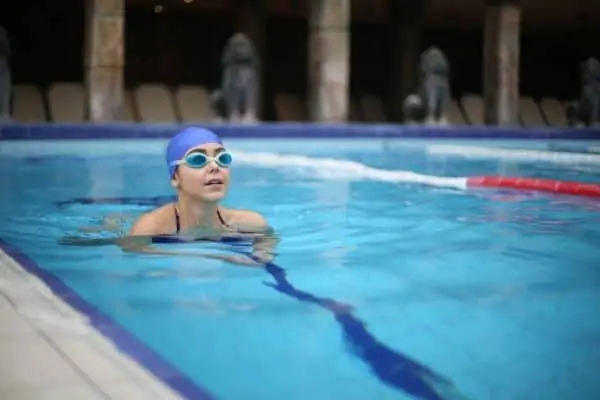Swimming in a pool with too much chlorine can be a concerning experience. While chlorine is essential for keeping pool water clean and safe, excessive levels can adversely affect swimmers.
Understanding the potential risks and managing chlorine levels is crucial for anyone who owns, maintains, or enjoys a swimming pool.
Well, we’ll be going over:
- What are the potential health effects of swimming in a pool with high chlorine levels?
- How can you identify if a pool has too much chlorine and the safe swimming levels?
- What steps can you take to reduce chlorine levels in a pool and protect swimmers from exposure?
Let’s explore the importance of managing chlorine levels in swimming pools to ensure a safe and enjoyable swimming experience for everyone.

Swimming in a pool with too much chlorine can be unsafe, causing skin, eye, and respiratory irritation. Safe chlorine levels range from 1-5 ppm. High levels, above 4 ppm, can lead to discomfort and health risks. Excess chlorine can be lowered by stopping chlorine addition, using sunlight exposure, diluting with fresh water, or adding chlorine neutralizers like sodium thiosulfate. Regular water testing ensures safe chlorine levels and swimming conditions.
What is the highest chlorine level safe to swim in?
Chlorine is crucial in maintaining the cleanliness and safety of swimming pools and spas. It acts as a disinfectant, eliminating harmful bacteria, viruses, and microorganisms that can cause health issues among swimmers.
However, while chlorine is essential for ensuring a clean and safe swimming environment, managing its concentration is important to provide swimmers with a pleasant and risk-free experience.
According to safety guidelines, the chlorine level in swimming pools and spas should not exceed 4 parts per million (ppm). This upper limit is set to balance the need for effective disinfection without causing discomfort or potential harm to swimmers.
It is a threshold beyond which swimmers may experience irritating effects such as red, stinging eyes, itchy skin, and even respiratory discomfort.
Signs of too much chlorine in a pool
If you go swimming with high chlorine in a pool, it can affect your body in different ways. The higher the chlorine concentration, the more severe your reaction may be.
Here are some signs of too much chlorine in pool:
- Itchy, irritated eyes
- Skin redness
- Dry or itchy skin
- Rash or hives
- Asthma
- Irritation to the respiratory tract
Chlorine poisoning
In rare instances, an extremely over-chlorinated pool may cause chlorine poisoning. Some signs to watch out for include:
- Watery eyes and blurry vision
- Coughing, wheezing, or difficulty breathing
- Tightness or dull pain in the chest
- Pain or burning in the eyes, nose, or throat
- Nausea or vomiting
Most reactions to chlorine are mild and will disappear within a day. If you are in pain or discomfort, getting checked out by a healthcare professional may be smart.
Effects of Excessive Chlorine Table
| Sign / Symptom | Potential Cause | Short-Term Effects | Long-Term Risks | Recommended Action |
|---|---|---|---|---|
| Skin Irritation & Dryness | Chlorine levels too high, causing chemical imbalance | Redness, itchiness, flaking skin | Chronic irritation or eczema flare-ups | Rinse off immediately; apply moisturizer; test & reduce chlorine levels. |
| Eye Redness & Burning | Over-chlorination and pH imbalance | Watery eyes, stinging sensation | Possible damage to cornea if exposure is repeated over time | Use artificial tears; adjust pH & chlorine to recommended levels. |
| Strong Chemical Odor | Excess combined chlorine (chloramines) in the water | Unpleasant smell around pool area, potential respiratory discomfort | Potential respiratory issues if inhaled consistently | Shock the pool correctly; ensure proper ventilation and adequate free chlorine. |
| Faded Swimwear / Pool Liners | Elevated chlorine concentration | Discoloration or faster wear and tear on fabrics and surfaces | Higher repair or replacement costs over time | Dilute pool water to safe level; avoid repeated exposure to overly chlorinated water. |
| Respiratory Irritation | Breathing in high chloramine fumes | Coughing, throat irritation | Aggravation of asthma or other respiratory conditions | Increase ventilation; consider an outdoor break; re-test chemical balance. |
What chlorine level is too high to swim?
Sometimes, you must raise the chlorine level higher than usual to super-chlorinate it. This process is done to remove algae, bacteria, and chloramine. When a pool is super-chlorinated, the chlorine level is raised to between 10 ppm and 20 ppm. These levels are unsafe to swim in and can burn or irritate your skin and eyes.
Is 20 ppm chlorine dangerous? Chlorine levels this high are potentially dangerous to swim in. When the chlorine level is above the acceptable range of 4 ppm, it’s best to wait before swimming.
Sometimes, waiting a short while is all that’s needed for the chlorine level to drop down to a safer range. Other times, you may need to lower the chlorine level before entering the pool again.
How Long Do You Have to Wait to Swim After Shocking a pool?
How to lower chlorine in pool
If the chlorine level in your pool has become too high, you may need to work to bring the level down. There are several things you can do to fix an over-chlorinated pool.
Stop chlorinating the pool
It may seem like common sense, but it is one thing to check. While you are trying to lower the level, make sure no sources are adding more chlorine. This includes salt cell chlorinators and floating chlorine dispensers.
Leave the pool uncovered
A bright sunny day can help to lower the level of chlorine quickly. The ultraviolet in sunlight breaks apart the chlorine and releases it. While the hot summer sun is a significant cause for needing more chlorine, you can use that to your advantage while trying to lower the level.
So, if you have a solar pool cover then leave it off and after a few hours, test the water to measure the chlorine level.
Add water
Draining some of the water from your pool and adding fresh water can help dilute the amount of chlorine. This may work if your chlorine level is elevated only slightly. This may not be an option if it is very high because of the water needed.
Add chlorine neutralizer or other chemicals
If you want to reduce the chlorine level quickly, add chemicals to your pool to help. A chlorine neutralizer works effectively and rapidly. If the chlorine level is very high, you may need to add a second dose.
Common chlorine neutralizers are sodium thiosulfate and hydrogen peroxide.
Read my post How to lower chlorine levels in a pool for full details.
Wait until the chlorine level of your pool is safe again
After working to lower the chlorine level in your pool, is the water safe?
Before entering the pool, test the water to ensure the chlorine level is acceptable. You may need to wait longer for the chlorine to reach a safer level.
Giving it time to work is imperative if you have added a chlorine neutralizer or other chemical. When your pool chlorine measures between 1 ppm and 5 ppm, it is safe for swimming again.

Safeguarding your eyes from exposure to chlorine and removing any traces of it from your body post-swim are essential steps in reducing potential reactions.
Importance of testing chlorine levels in your pool
If you own a pool, you know the importance of testing the water regularly. Checking the water is the only way to know if it has the proper chlorine level. Signs, such as the water color or smell, let you know your pool needs some chemicals added. But without testing, there is no way to know the exact levels.
Strong pool smell
A pool that smells like chlorine may have you wondering if it has been over-chlorinated.
The opposite is true. What you are smelling is not actually chlorine but a chemical compound called chloramine.
Chloramine occurs from a mixture of chlorine with sweat, dirt, or urine from swimmers. Unhygienic behavior – such as peeing in the pool or not showering first – causes the available chlorine to be used quickly. Proper hygiene is critical for maintaining a healthy pool.
If you can smell the chlorine in a pool, it is a sign that the water could need more chlorine, not less.
Adding more chlorine will eliminate the chlorinates that cause the smell. A properly maintained pool should have no odor at all.
Safe levels of chlorine
Chlorine works to disinfect the water in the pool. It keeps us safe by killing many types of germs. But to work, the proper amount of chlorine is needed. Use a liquid test kit or test strips to help determine the amount of chlorine in your pool.
Besides chlorine, test kits and strips will determine other levels in your pool. A pool is balanced when all are within their proper levels.
| Chemical | Ideal Range | Acceptable Range |
| Chlorine | 2-4 ppm | 1-5 ppm |
| pH | 7.4-7.6 | 7.2-7.8 |
| Total Alkalinity | 80-100 ppm | 60-120 ppm |
| Calcium Hardness | 200-400 ppm | 150-1000 ppm |
Summary
In a pool with excessive chlorine levels, the consequences of swimming in such conditions can be detrimental to a swimmer’s health. Too much chlorine in the pool water can lead to several adverse effects.
So what happens if you swim in a pool with too much chlorine? High chlorine levels can irritate the skin, eyes, and respiratory system, causing redness, itching, stinging sensations, eye-watering, coughing, and difficulty breathing. Pool owners and operators need to maintain appropriate chlorine levels to ensure the safety and well-being of swimmers.
Is 20 ppm chlorine dangerous in a pool?
20ppm is much too high a chlorine level to swim in as the level should be no higher than 4ppm.
Is 10 ppm chlorine safe to swim in?
10ppm is too high a chlorine level to swim in as the level should be no higher than 4ppm.
What to do if chlorine is too high in pool?
You should:
Stop adding any more chlorine until the level has dropped
Do not cover the pool to allow sunlight to dissipate the chlorine
Partially drain and add new water
Use Chlorine neutralizer






Leave a Reply